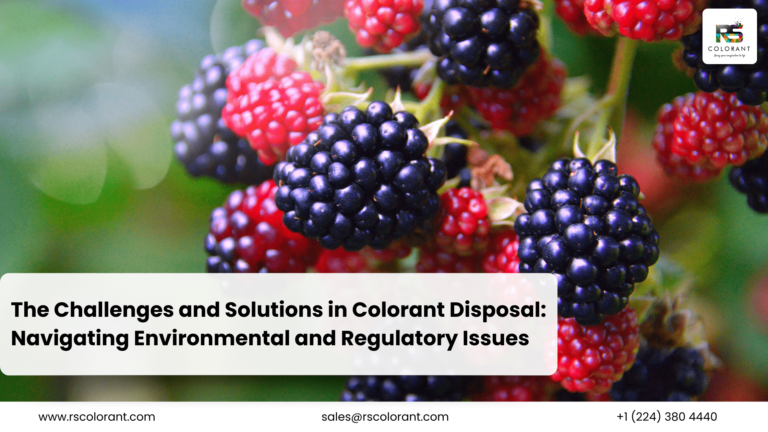Introduction
Color is everywhere—it’s in the clothes we wear, the food we eat, and even the products we buy. But have you ever stopped to think about how these colors influence your decisions? From the bright red of a Coca-Cola can to the soothing blue of a skincare product, color plays a pivotal role in shaping our perceptions and behaviors as consumers. In this article, we’ll explore the fascinating world of colorants and how they impact consumer behavior across various industries.
Understanding Colorants
Definition of Colorants
Colorants are substances used to impart color to products, ranging from food and beverages to textiles and cosmetics. They can be derived from natural sources, like plants and minerals, or created synthetically in laboratories. The primary purpose of colorants is to enhance the appearance of products, making them more appealing to consumers.
Types of Colorants: Natural vs. Synthetic
There are two main types of colorants: natural and synthetic. Natural colorants are derived from organic sources such as fruits, vegetables, and spices. Examples include beet juice for red coloring and turmeric for yellow. Synthetic colorants, on the other hand, are chemically manufactured and offer a wider range of colors with greater consistency. While synthetic colorants are often more vibrant and stable, they can be associated with health concerns, leading to a growing demand for natural alternatives.
Common Industries Using Colorants
Colorants are widely used across various industries, including food and beverages, cosmetics, textiles, and even pharmaceuticals. In each of these industries, colorants serve not only to enhance the aesthetic appeal of products but also to convey specific messages and evoke certain emotions among consumers.
Psychology of Color
How Colors Influence Emotions
Colors have a powerful effect on our emotions and can influence our behavior in subtle ways. For instance, red is often associated with energy and excitement, making it a popular choice for brands that want to convey a sense of urgency or passion. Blue, on the other hand, is seen as calming and trustworthy, which is why it’s commonly used in the branding of financial institutions and healthcare products.
The Role of Cultural and Societal Factors
Cultural and societal factors also play a significant role in how colors are perceived. For example, while white is associated with purity and weddings in many Western cultures, it is linked to mourning in some Eastern cultures. Understanding these cultural nuances is crucial for brands aiming to connect with diverse consumer bases.
The Science Behind Color Perception
The way we perceive color is rooted in science. When light hits an object, it absorbs some wavelengths and reflects others. The reflected wavelengths are what we perceive as color. This perception can be influenced by factors such as lighting, context, and individual differences in color vision.
Colorants and Brand Identity
How Color Shapes Brand Perception
Color is a key element of brand identity, helping to differentiate a brand from its competitors and communicate its values. For instance, the iconic red of Coca-Cola is instantly recognizable and evokes feelings of happiness and nostalgia. Brands carefully choose their colors to create a specific emotional response and to build brand recognition over time.
Case Studies of Iconic Brand Colors
Some of the most successful brands have built their identity around a specific color. For example, Tiffany & Co.’s distinctive robin’s-egg blue is synonymous with luxury and elegance. Similarly, McDonald’s uses red and yellow to evoke feelings of excitement and hunger, which aligns with its fast-food image.
The Significance of Consistency in Brand Colors
Consistency in the use of color across all marketing materials is crucial for building brand recognition. When consumers repeatedly see the same color associated with a brand, they begin to associate that color with the brand’s values and products. This consistency helps to reinforce the brand’s identity and makes it more memorable.
Colorants in Packaging
Importance of Packaging Color in Consumer Attraction
Packaging color is often the first thing a consumer notices about a product, making it a critical factor in the purchasing decision. Bright, bold colors can grab attention on crowded shelves, while more subdued tones can convey sophistication and luxury. The right choice of color can significantly increase the likelihood of a product being picked up and purchased.
How Packaging Colors Influence Purchasing Decisions
Research has shown that packaging colors can influence consumers’ perceptions of product quality, taste, and value. For example, green packaging is often associated with health and sustainability, making it a popular choice for organic and eco-friendly products. In contrast, black packaging is often used for premium products, as it conveys elegance and exclusivity.
Examples of Effective Packaging Color Strategies
Some brands have successfully used color in packaging to stand out in the market. For instance, Apple’s use of sleek white packaging reflects the brand’s minimalist and modern design philosophy. Similarly, the bright orange of Reese’s candy packaging is eye-catching and instantly recognizable, contributing to the brand’s strong market presence.
The Role of Colorants in Food and Beverages
The Appeal of Color in Food Presentation
Color is a critical factor in food presentation, as it can influence perceptions of freshness, flavor, and quality. For example, the vibrant red of ripe strawberries or the deep green of fresh spinach can make a dish more visually appealing and appetizing. In many cases, the color of food is directly linked to its perceived taste, with brighter colors often associated with stronger, more intense flavors.
Consumer Perceptions of Natural vs. Artificial Colors
Consumers are becoming increasingly aware of the ingredients in their food, leading to a growing preference for natural colorants over artificial ones. Natural colorants, derived from fruits, vegetables, and other organic sources, are perceived as healthier and more trustworthy. In contrast, artificial colorants are often viewed with suspicion due to potential health risks and concerns about synthetic chemicals.
Health Implications and Consumer Trust
The health implications of colorants, particularly synthetic ones, are a significant concern for many consumers. Studies have linked certain artificial colorants to health issues, leading to stricter regulations and a shift towards natural alternatives. As a result, brands that use natural colorants are often seen as more transparent and trustworthy, which can enhance consumer loyalty.
Colorants in the Cosmetics Industry
The Power of Color in Beauty Products
Color plays a central role in the cosmetics industry, influencing everything from lipstick and eyeshadow to nail polish and hair dye. The right color can enhance a person’s features, boost confidence, and even transform their appearance. As a result, consumers often choose cosmetics based on the color that best suits their skin tone, personality, and mood.
Trends in Natural Colorants in Cosmetics
With the rise of clean beauty, there’s been a growing demand for natural colorants in cosmetics. These colorants are derived from plants, minerals, and other organic sources, offering a safer and more eco-friendly alternative to synthetic dyes. Brands are increasingly using natural colorants to meet consumer demand for products that are not only effective but also sustainable and non-toxic.
Consumer Preference for Eco-Friendly and Sustainable Options
Today’s consumers are more environmentally conscious than ever before, leading to a preference for cosmetics that are made with sustainable ingredients and packaged in eco-friendly materials. Brands that use natural colorants and promote their sustainability efforts can attract a loyal customer base that values ethical and environmentally responsible products.
Colorants in the Textile Industry
The Influence of Color on Fashion Choices
Color is a powerful tool in fashion, influencing trends and driving consumer choices. Certain colors can evoke specific emotions and associations, making them popular choices for different seasons and occasions. For example, pastel colors are often associated with spring and are used in lighter, more casual clothing, while darker, richer colors are popular in fall and winter fashion.
The Rise of Eco-Friendly Dyes
As with other industries, the textile industry is seeing a shift towards more sustainable practices, including the use of eco-friendly dyes. These dyes are derived from natural sources and are less harmful to the environment than traditional synthetic dyes. The rise of eco-friendly dyes reflects a broader trend towards sustainability in fashion, with consumers increasingly seeking out brands that align with their environmental values.
Impact of Color Trends on Consumer Buying Behavior
Color trends can have a significant impact on consumer buying behavior, with certain colors becoming more popular in response to cultural shifts, technological advancements, and social media influence. Brands that stay ahead of color trends can capitalize on these shifts by offering products in the latest colors, attracting fashion-conscious consumers who want to stay on-trend.
Colorants in the Digital Age
The Significance of Color in Digital Marketing
In the digital age, color plays a crucial role in marketing and branding, particularly online. The colors used on a website, social media profiles, and digital ads can influence how a brand is perceived and whether consumers engage with the content. Bright, bold colors can grab attention and drive clicks, while softer, more muted tones can create a calming and inviting atmosphere.
Color Choices for Websites and Social Media
The choice of color for websites and social media is critical for creating a cohesive brand identity and enhancing user experience. For example, a website that uses too many bright, clashing colors may overwhelm visitors, leading to a high bounce rate. In contrast, a well-designed site with a harmonious color scheme can improve user engagement and increase conversions.
The Role of Color in Online Shopping Experiences
Color can also play a significant role in online shopping experiences, influencing everything from product images to the “Add to Cart” button. Studies have shown that color can affect consumers’ perceptions of product quality, value, and desirability, ultimately impacting their purchasing decisions. By strategically using color, brands can enhance the online shopping experience and drive sales.
Sustainability and Ethical Considerations
The Environmental Impact of Synthetic Colorants
Synthetic colorants, while offering a wide range of colors and consistency, can have significant environmental impacts. The production and disposal of synthetic dyes often involve harmful chemicals that can pollute water sources and harm ecosystems. As awareness of these environmental impacts grows, consumers are increasingly seeking out products that use natural and eco-friendly colorants.
Consumer Demand for Sustainable Options
As consumers become more environmentally conscious, there is a growing demand for sustainable products, including those made with natural colorants. Brands that prioritize sustainability in their colorant choices can attract eco-conscious consumers and differentiate themselves in the market. This shift towards sustainability is not just a trend but a fundamental change in consumer expectations.
How Brands Are Adapting to Ethical Colorant Choices
To meet consumer demand for sustainability, many brands are adopting ethical colorant choices, such as using natural dyes, reducing waste, and implementing eco-friendly production processes. These efforts not only appeal to consumers but also contribute to a positive brand image and long-term success in an increasingly competitive market.
Challenges and Controversies
Health Concerns Associated with Synthetic Colorants
One of the biggest challenges in the use of synthetic colorants is the potential health risks they pose. Some synthetic dyes have been linked to allergic reactions, hyperactivity in children, and even cancer. These concerns have led to increased scrutiny and regulation, as well as a shift towards natural alternatives.
Legal Regulations and Industry Standards
The use of colorants is subject to strict legal regulations and industry standards, which vary by country and industry. For example, the European Union has banned certain synthetic colorants due to health concerns, while other regions may have more lenient regulations. Brands must navigate these regulations carefully to ensure compliance and avoid potential legal issues.
The Debate Over Transparency in Labeling
Transparency in labeling is a hotly debated topic, particularly when it comes to colorants. Consumers are demanding more information about the ingredients in their products, including the type and source of colorants used. Brands that prioritize transparency and provide clear, accurate labeling can build trust with consumers and stand out in a crowded market.
The Future of Colorants
Innovations in Natural Colorants
The future of colorants is likely to see continued innovation in natural alternatives, driven by consumer demand for safer and more sustainable options. Advances in biotechnology, for example, are enabling the development of new, more vibrant natural colorants that can compete with synthetic dyes in terms of performance and cost.
Predicting Future Trends in Consumer Preferences
As consumer preferences continue to evolve, we can expect to see a greater emphasis on transparency, sustainability, and health in the use of colorants. Brands that stay ahead of these trends and adapt their products accordingly will be well-positioned to succeed in the future market.
How Brands Can Stay Ahead in Colorant Technology
To stay ahead in the rapidly changing world of colorants, brands must invest in research and development, embrace innovation, and prioritize sustainability. By doing so, they can meet the evolving needs of consumers and maintain a competitive edge in the market.
Conclusion
Colorants play a crucial role in consumer behavior, influencing everything from product perception to brand loyalty. As consumers become more informed and environmentally conscious, the demand for natural and sustainable colorants is likely to grow. Brands that understand the impact of colorants and adapt to changing consumer preferences will be better equipped to thrive in an increasingly competitive market.
FAQs
What are colorants, and why are they important?
Colorants are substances used to add color to products, making them more visually appealing and helping to convey certain messages to consumers. They are important because they influence consumer perceptions, brand identity, and purchasing decisions.
How do colors influence consumer behavior?
Colors can evoke specific emotions and associations, influencing how consumers feel about a product or brand. For example, red can create a sense of urgency, while blue can convey trust and calmness. These emotional responses can drive consumer behavior and purchasing decisions.
Are natural colorants better than synthetic ones?
Natural colorants are often perceived as healthier and more environmentally friendly than synthetic ones. However, they may not always offer the same vibrancy or stability as synthetic dyes. The choice between natural and synthetic colorants depends on the product, consumer preferences, and regulatory considerations.
How can brands use color effectively in marketing?
Brands can use color to create a strong, recognizable identity and evoke specific emotions in consumers. Consistency in color use across all marketing materials is key to building brand recognition. Additionally, understanding cultural and societal color associations can help brands connect with diverse audiences.
What is the future of colorants in the industry?
The future of colorants is likely to see continued innovation in natural and sustainable options, driven by consumer demand for safer, more eco-friendly products. Advances in technology and a focus on transparency and ethical practices will shape the future of colorants in various industries.




